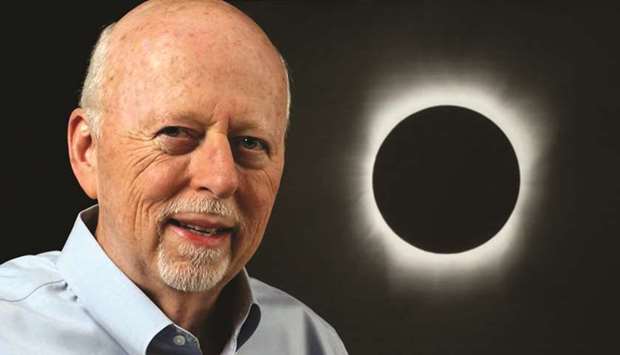— Bryan Brewer, eclipse expert
Got questions about the solar eclipse happening August 21? Five seconds on Google will get you more than 10 million results — including interactive maps that zoom in on the zone of totality from coast to coast.
But the last time the Pacific Northwest experienced a total solar eclipse, information wasn’t as easy to come by.
“You went to the library,” recalled Bryan Brewer. “And you did a lot of things by phone and mail.” Among them: dialling up the US Naval Observatory to request pamphlets showing the eclipse path.
Brewer, then a 32-year-old technical writer at Boeing, became intrigued with the subject when he learned that southern Washington and northern Oregon would be in the prime viewing zone for the eclipse of February 26, 1979. He thought it would be the perfect setting for a reunion with college friends.
But the research was frustrating. Most of the books Brewer found were highly technical. None combined history, science and eclipse lore in a concise, readable format.
“I couldn’t find a good book on the subject,” he said, “so I decided to write my own.”
Thirty-eight years later, the competition is stiffer.
The upcoming total eclipse of the sun will be the first of the Internet age in the contiguous United States, and its approach is being heralded by a deluge of data, websites, publications and guides. Search for “eclipse books” on Amazon, and hundreds of titles pop up.
That includes a new edition of Brewer’s self-published book, Eclipse: History. Science. Awe. The introduction, written by the late sci-fi luminary Frank Herbert, author of Dune and then-Port Townsend resident, remains unchanged. But Brewer, now 70 and working as a startup consultant, spruced up the package with colour images and revised the text to focus on this year’s epidemic of eclipse fever.
“There was a lot of enthusiasm in 1979, but it wasn’t nearly as widespread as today,” he said. “The level of interest is just increasing exponentially as you get closer to the day.”
Still, some people don’t seem to appreciate the vast difference between a partial and total eclipse — or how moving the experience can be, Brewer added. One of his neighbours recently mentioned that her family planned to take in the event from Seattle, where the moon will block about 95 percent of the sun’s surface.
While 95 percent sounds close to 100 percent, the effect is not comparable. Even at 99 percent, a sliver of the sun remains uncovered — which means none of the striking features of a total eclipse are visible.
“It’s only when you get to 100 percent that the experience is just off the charts,” Brewer said. “If you’re interested in this, make sure you get in the path of totality.”
His memories of that February morning in 1979 remain vivid. He and a dozen friends bundled up in down parkas and drove to the top of a bluff near Goldendale, Klickitat County, just north of the Columbia River and about 100 miles east of Portland. Clouds that threatened to block their view parted at the last minute.
“The anticipation was palpable,” Brewer said. For about an hour, the moon crept slowly over the face of the sun. Clouds blocked the view, “Then: Boom!”
The bluff was plunged into twilight. Birds fell silent. Stars shone. And the solar corona — the star’s normally invisible outer fringe — burst into view.
In the introduction to his book American Eclipse, science writer David Baron describes his initiation into the ranks of umbraphiles — eclipse-chasers — this way:
“For three glorious minutes, I felt transported to another planet, indeed to a higher plane of reality, as my consciousness departed the earth and I gaped at an alien sky.
“Above me, in the dim vault of the heavens, shone an incomprehensible object. It looked like an enormous wreath woven from silvery thread and it hung suspended in the immensity of space, shimmering. As I stood transfixed by this vision, I felt something I had never experienced before — a visceral connection to the universe … ”
Brewer felt that connection, too, and it’s what led him to travel the globe to experience it again.
He led a tour to an eclipse in Brazil in 1994 and was on a cruise ship in the Caribbean that outran clouds to get a clear view of an eclipse in 1998. The feeling of awe intrigued him so much that he added a section to the book about new research that shows benefits ranging from a calm-yet-energised state to feelings of openness.
“A total solar eclipse delivers a big dose of awe in a big way,” he said.
Ancient peoples also experienced awe, but often mixed with terror. Across much of Asia, peasants and soldiers used to bang drums and shoot arrows into the sky to chase away the dragon that was eating the sun, according to Brewer’s book. In 585BC, the shocking spectre of a total solar eclipse inspired two warring armies to lay down their swords and make peace.
British troops granted safe passage for an American eclipse expedition to the Gulf of Maine during the Revolutionary War — but Baron reports that the organisers got the location wrong and missed the event. American Eclipse also recounts the race to document an 1878 eclipse on the western frontier at a time when the young country was eager to establish its scientific bona fides.
Eclipses don’t occur like clockwork, but they do follow patterns that were discovered thousands of years ago by the Babylonians and other ancient civilisations. Mapping out the exact path of totality was a tougher problem that took scientists centuries to refine.
In 1925, scientists tested their predictions by enlisting residents of New York City to line up along the Hudson River and note exactly where the moon’s shadow passed over the metropolis. Part of the mystique of total solar eclipses is their geographical rarity, Brewer said. The sun is completely eclipsed somewhere on Earth about every 18 months — but only along a narrow swath. In 1979, that swath grazed the northwestern corner of the United States, then looped into Canada.
August 21 will mark the first coast-to-coast eclipse in the US in 99 years — and the path of totality will be about 70 miles wide. For Northwesterners, another total solar eclipse won’t come close until 2044, when the path will extend through the eastern half of British Columbia.
“Unless you want to go chase eclipses,” Brewer said, “for most people, it’s a once-in-a-lifetime opportunity.” —The Seattle Times/TNS



